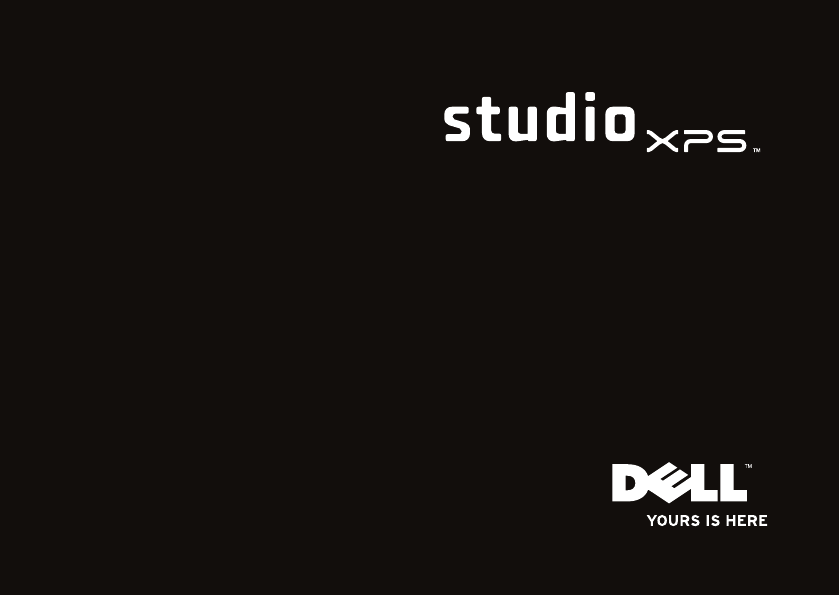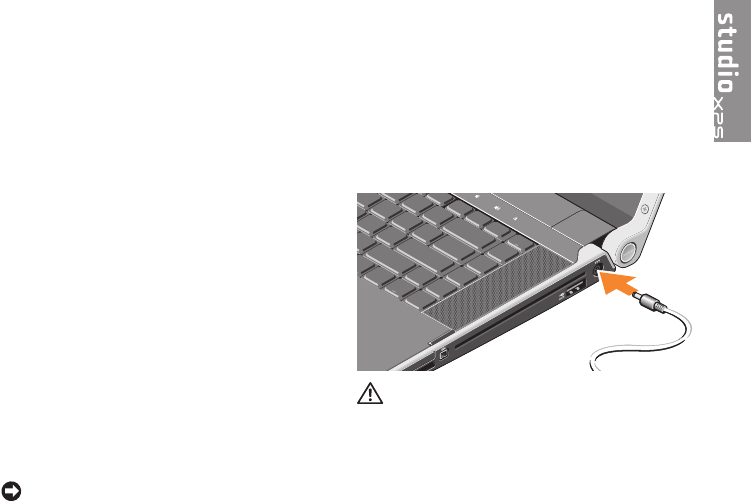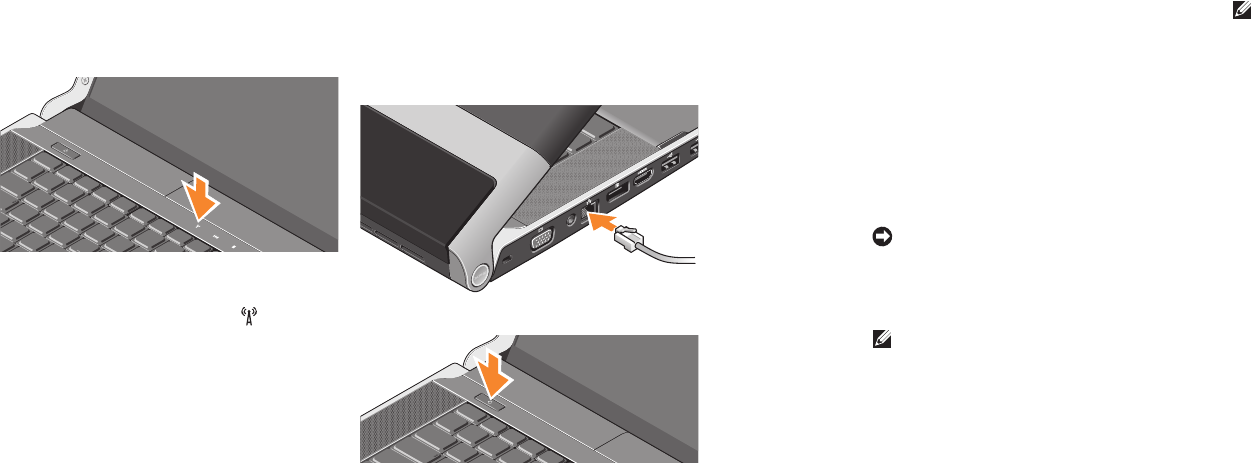Inseego NVWE760D PCI Express Mini Card User Manual 2
Novatel Wireless Inc PCI Express Mini Card 2
Inseego >
Contents
User Manual 2

SETUP GUIDE

SETUP GUIDE
Model PP35L

Setting Up Your Studio XPS Laptop � � � � � � �5
Before Setting Up Your Computer . . . . . . . . . 5
Connect the AC Adapter . . . . . . . . . . . . . . . .5
Check the Wireless Button . . . . . . . . . . . . . . 6
Connect the Network Cable (optional) . . . . .6
Press the Power Button . . . . . . . . . . . . . . . . . 6
Windows Vista® Setup . . . . . . . . . . . . . . . . . . 7
Connect to the Internet (Optional) . . . . . . . . . 7
Set up the TV Tuner (Optional)
(availability varies by regions) . . . . . . . . . . . . 9
Using Your Dell™ Laptop � � � � � � � � � � � � � � �10
Device Status Lights . . . . . . . . . . . . . . . . . . . 10
Right Side Features . . . . . . . . . . . . . . . . . . . . 11
Left Side Features . . . . . . . . . . . . . . . . . . . . . 13
Display Features . . . . . . . . . . . . . . . . . . . . . . 15
Media, Wireless, and Power Controls . . . . . 16
Computer Base and Keyboard Features . . . 17
Using the Optical Disc Drive. . . . . . . . . . . . . 19
Software Features . . . . . . . . . . . . . . . . . . . . . 20
Solving Problems � � � � � � � � � � � � � � � � � � � � �22
Network Problems . . . . . . . . . . . . . . . . . . . . . 22
Power Problems. . . . . . . . . . . . . . . . . . . . . . . 23
Memory Problems . . . . . . . . . . . . . . . . . . . . . 23
Lockups and Software Problems . . . . . . . . . 24
Using Support Tools� � � � � � � � � � � � � � � � � � �26
Dell Support Center . . . . . . . . . . . . . . . . . . . . 26
System Messages . . . . . . . . . . . . . . . . . . . . . 27
Hardware Troubleshooter . . . . . . . . . . . . . . . 28
Dell Diagnostics . . . . . . . . . . . . . . . . . . . . . . 29
Restoring Your Operating System � � � � � � �30
System Restore . . . . . . . . . . . . . . . . . . . . . . . 30
Contents
Notes, Notices, and Cautions
NOTE: A NOTE indicates important information that helps you make better use of your
computer.
NOTICE: A NOTICE indicates either potential damage to hardware or loss of data and tells you
how to avoid the problem.
CAUTION: A CAUTION indicates a potential for property damage, personal injury, or death.
__________________
Information in this document is subject to change without notice�
© 2008 Dell Inc� All rights reserved�
Reproduction of these materials in any manner whatsoever without the written permission of Dell Inc. is strictly forbidden.
Trademarks used in this text:
Dell
, the
DELL
logo,
XPS,
and
DellConnect
are trademarks of Dell Inc.;
Intel
is a registered
trademarks and
Core
is a trademark of Intel Corporation;
Microsoft
,
Windows
, and
Windows Vista
are either trademarks
or registered trademarks of Microsoft Corporation in the United States and/or other countries.;
Blu-ray Disc
is a
trademark of the Blu-ray Disc Association;
Bluetooth
is a registered trademark owned by Bluetooth SIG, Inc. and is used
by Dell under license.
Other trademarks and trade names may be used in this document to refer to either the entities claiming the marks and
names or their products. Dell Inc. disclaims any proprietary interest in trademarks and trade names other than its own.
PP35L
May 2008 P/N R558D Rev� A00

4
Setting Up Your Studio XPS Laptop
This section provides information about setting
up your Studio XPS 1640 and connecting
peripherals.
Before Setting Up Your Computer
When positioning your computer, ensure that
you allow easy access to a power source,
adequate ventilation, and a level surface to
place your computer.
Restricting airflow around your Studio XPS
computer may cause it to overheat. To prevent
overheating ensure that you leave at least
10.2 cm (4 in) at the back of the computer and a
minimum of 5.1 cm (2 in) on all other sides. You
should never put your computer in an enclosed
space, such as a cabinet or drawer when it is
powered on.
NOTICE: Placing or stacking heavy or sharp
objects on the computer may result in
permanent damage to the computer.
Connect the AC Adapter
Connect the AC adapter to the computer and
then plug it into a wall outlet or surge protector.
CAUTION: The AC adapter works with
electrical outlets worldwide� However,
power connectors and power strips vary
among countries� Using an incompatible
cable or improperly connecting the cable
to a power strip or electrical outlet may
cause fire or equipment damage�
Dell Factory Image Restore . . . . . . . . . . . . . 31
Operating System Reinstallation . . . . . . . . . 33
Getting Help � � � � � � � � � � � � � � � � � � � � � � � � �35
Technical Support and Customer Service . . 36
DellConnect™ . . . . . . . . . . . . . . . . . . . . . . . . . 36
Online Services . . . . . . . . . . . . . . . . . . . . . . . 36
AutoTech Service. . . . . . . . . . . . . . . . . . . . . . 37
Product Information. . . . . . . . . . . . . . . . . . . . 38
Returning Items for Repair Under Warranty
or for Credit . . . . . . . . . . . . . . . . . . . . . . . . . . 38
Before You Call. . . . . . . . . . . . . . . . . . . . . . . . 39
Contacting Dell. . . . . . . . . . . . . . . . . . . . . . . . 40
Finding More Information
and Resources � � � � � � � � � � � � � � � � � � � � � � �41
Basic Specifications � � � � � � � � � � � � � � � � � �43
Index � � � � � � � � � � � � � � � � � � � � � � � � � � � � � � �52

6
Setting Up Your Studio XPS Laptop
7
Setting Up Your Studio XPS Laptop
Windows Vista® Setup
Your Dell computer is preconfigured with
Windows Vista. To set up Windows Vista for
the first time, follow the instructions on the
screen. These steps are mandatory and may
take up to 15 minutes to complete. The screens
will take you through several procedures
including accepting license agreements,
setting preferences and setting up an Internet
connection.
NOTICE: Do not interrupt the operating
system’s setup process. Doing so may
render your computer unusable.
Connect to the Internet (Optional)
NOTE: ISPs and ISP offerings vary by
country.
To connect to the Internet, you need an external
modem or network connection and an Internet
service provider (ISP).
NOTE: If an external USB modem or
WLAN adapter is not part of your original
order you can purchase one from the Dell
website at dell�com.
Setting Up a Wired Internet Connection
If you are using a dial-up connection, connect
the telephone line to the external USB modem
(optional) and to the telephone wall jack
before you set up your Internet connection. If
you are using a DSL or cable/satellite modem
connection, contact your ISP or cellular
telephone service for setup instructions.
Setting Up a Wireless Connection
Before you can use your wireless Internet
connection, you need to connect to your
wireless router.
Check the Wireless Button
If you plan to use wireless connections, make
sure the wireless button is turned on.
Using The Wireless Button
To turn on wireless, with the system turned on,
lightly touch the wireless symbol on the
center control cover and then release.
Connect the Network Cable
(optional)
If you plan to use a wired network connection,
plug in the network cable.
Press the Power Button

8
Setting Up Your Studio XPS Laptop
9
Setting Up Your Studio XPS Laptop
Choose b. Dial-up if you will use an optional
USB dial-up modem or ISDN.
NOTE: If you do not know which type of
connection to select, contact your ISP.
Follow the instructions on the screen and 5�
use the setup information provided by your
ISP to complete the setup.
Set up the TV Tuner (Optional)
(availability varies by regions)
You can set up the TV Tuner through the Media
Center.
To set up the TV Tuner for the first time:
Follow this procedure if you are launching the
Media Center for the first time.
Double-click on the Media Center icon on the
desktop.
Select • Express setup,
Go to – Main Menu → Tasks → Settings →
TV → Set up TV Signal → Confirm Your
Region and follow the instructions given.
Go to – Main Menu → TV + Movies → Set
up TV → Confirm Your Region and follow
the instructions given
Select • Custom setup,
Follow the instructions given. –
In the – Optional Setup screen, choose
Configure tuners, TV signal, and Guide.
Click – Next and confirm your region.
To re-setup the TV Tuner, if required:
Follow this procedure if you have already
launched Media Center once before.
Double-click on the Media Center icon on 1�
the desktop.
Go to 2� Main Menu → Tasks → Settings → TV
→ Set up TV Signal → Confirm Your Region.
To set up your connection to a wireless router:
Save and close any open files, and exit any 1�
open programs.
Click 2� Start → Connect To.
Follow the instructions on the screen to 3�
complete the setup.
Setting Up Your Internet Connection
To set up an Internet connection with a provided
ISP desktop shortcut:
Save and close any open files, and exit any 1�
open programs.
Double-click the ISP icon on the Microsoft2� ®
Windows® desktop.
Follow the instructions on the screen to 3�
complete the setup.
If you do not have an ISP icon on your desktop
or if you want to set up an Internet connection
with a different ISP, perform the steps in the
following section.
NOTE: If you cannot connect to the Internet
but have successfully connected in the
past, the ISP might have a service outage.
Contact your ISP to check the service
status, or try connecting again later.
NOTE: Have your ISP information ready. If
you do not have an ISP, the Connect to the
Internet wizard can help you get one.
Save and close any open files, and exit any 1�
open programs.
Click 2� Start → Control Panel.
Under 3� Network and Sharing Center, click
Connect to a Network.
The Connect to a Network window appears.
Click either 4� Connect to the Internet to
connect to the network using a wireless or
Broadband (PPPoE) or click Set up a dial-up
connection, depending on how you want to
connect:
Choose a. Broadband if you will use a DSL,
satellite modem, cable TV modem, or
wireless technology connection.

11
Using Your Dell™ Laptop
3 WiFi status light – Turns on when
wireless networking is enabled.
Use the wireless button to quickly turn all
wireless communication On and Off:
Using The Wireless Button
To turn on wireless, with the system turned
on, lightly touch the wireless symbol
on the center control cover and then
release.
4WWAN status light - Turns on when
WWAN is enabled.
To turn on wireless, with the system turned
on, lightly touch the wireless symbol
on the center control cover and then
release.
Right Side Features
123
456
1 ExpressCard slot – Supports one
ExpressCard. The computer ships with a
plastic blank installed in the slot.
Your computer has several indicators, buttons,
and features that provide information at-a-
glance and time-saving shortcuts for common
tasks.
Device Status Lights
1234
1 Hard drive activity light – Turns on
when the computer reads or writes data. A
flashing light indicates hard drive activity.
NOTE: To avoid loss of data, never
turn off the computer while the hard
drive activity light is flashing.
2 Bluetooth® status light (optional)
– Turns on when a card with Bluetooth
wireless technology is enabled.
NOTE: The card with Bluetooth
wireless technology is an optional
feature.
To turn off Bluetooth wireless, right-click
the bluetooth icon in the notification
area of your desktop, and click Disable
Bluetooth Radio or use the wireless
switch.
Using Your Dell™ Laptop

12
Using Your Dell™ Laptop
13
Using Your Dell™ Laptop
5 eSATA/USB combo connector with
USB PowerShare –
Connects to eSATA compatible storage
devices, such as external hard disk drives
or optical drives. Also, supports USB
devices, such as a mouse, keyboard,
printer, external drive, or MP3 player
This connector can also be used for
charging USB devices.
NOTE: If the computer is turned off
while the USB device is charging,
unplug the device and plug it in again
to continue charging.
NOTE: The USB PowerShare will be
automatically shut off when only 10%
of total battery life remains.
6 AC adapter connector – Connects to
the AC adapter to power the computer and
charge the battery when the computer is
not in use.
Left Side Features
7
6
5
4
3
2
1
89
1Security cable slot – Used to attach a
commercially available antitheft device to
the computer.
NOTE: Before you buy an antitheft
device, ensure that it works with the
security cable slot on your computer.
2
SD/MMC - MS/Pro - xD
8-in-1 Media card reader – Provides a
fast and convenient way to view and
share digital photos, music, videos, and
documents stored on the following digital
memory cards:
Secure digital (SD) memory card•
SDHC (Secure Digital High Capacity) •
card
Multi Media Card (MMC)•
Memory Stick•
Memory Stick PRO•
xD-Picture Card (type - M and type - H)•
3 IEEE 1394 connector – Connects to
high-speed serial multimedia devices,
such as digital video cameras
4Optical Drive – Plays or burns only
standard-size and shape (12 cm) CDs, and
DVDs. Ensure that the side with print or
writing is facing upward when inserting
discs
NOTE: Do not use non-standard-size
or shape discs (including mini-CDs
and mini-DVDs) or you will damage
the drive.
12 cm

14
Using Your Dell™ Laptop
15
Using Your Dell™ Laptop
Display Features
The display panel holds a camera and
accompanying dual microphones.
3
1245
1Display – Your display can vary based on
selections you made when purchasing
your computer. For more information about
displays, see the Dell Technology Guide.
2Left digital array microphone – Combines
with the right digital array microphone
to provide high quality sound for video
chatting and voice recording.
3Camera activity light – Turns on when the
camera is on.
4Camera – Built-in camera for video
capture, conferencing, and chat.
FastAccess Facial Recognition – Helps
to keep your Dell™ computer secure.
This facial recognition software learns
and recognizes your face each time you
login to your computer and minimizes the
need to manually login using passwords.
For more information, click Start →
Programs→ FastAccess.
5Right digital array microphone – Combines
with the left digital array microphone
to provide high quality sound for video
chatting and voice recording.
2 VGA connector – Connects to a
monitor or projector.
3TV In connector – Connects to a TV to
view programs using the TV Tuner card
(optional, availability varies according to
regions).
4 Network connector – If you are
using a cabled network signal, this
connects your computer to a network or
broadband device.
5DisplayPort connector – Digital
interface standard connector that
supports external DisplayPort monitors
and projectors.
6 HDMI connector – Connects to a TV
for both audio and video signals.
NOTE: For a monitor, only the video
signal will be read.
7 USB connectors (2) – Connect USB
devices, such as a mouse, keyboard,
printer, external drive, or MP3 player.
8 Audio In/ Microphone connector –
Connect to a microphone or input signal
for use with audio programs.
9 Audio Out/ Headphone connectors (2)
– Connect one or two pairs of headphones,
or send audio to a powered speaker or
sound system. The audio signal is the
same for both connectors.

16
Using Your Dell™ Laptop
17
Using Your Dell™ Laptop
To use the media, wireless, and power controls, lightly touch the symbol and then release. The
control’s symbol will shine for 2 seconds to confirm your selection then fade away.
Turn on power, or wake up from sleep
state
Turn on wireless
Play the previous track or chapter
Stop
Play or pause
Play the next track or chapter
Turn down the volume
Turn up the volume
Mute the sound
Eject the disc
Media, Wireless, and Power Controls Computer Base and Keyboard
Features
1Touch pad – Provides the functionality of
a mouse to move the cursor, drag or move
selected items, and left-click by tapping
the surface.
It supports circular scrolling and zoom.
To change the circular scrolling and zoom
settings, double-click the Dell Touch
pad icon in the notification area of your
desktop.
In the Scrolling tab, enable or disable
scrolling or circular scrolling, choose the
scroll zone width and scroll speed.
In the Gestures tab, enable or disable the
one-finger zoom (zoom in and out moving
the finger upward or downward) or the
pinch zoom (zoom in and out by spreading
two fingers or by bringing the two fingers
together).
2Touch pad buttons – Provide left- and
right-click functions like those on a mouse.
4
3
2
1

18
Using Your Dell™ Laptop
19
Using Your Dell™ Laptop
3Backlit Keyboard – The backlit keyboard
provides visibility in dark environments
by illuminating all symbols on the keys.
For more information see
Dell Technology
Guide.
4Consumer IR - Allows certain software
applications to be controlled by the Dell
Travel Remote (an optional device that can
be stored in the ExpressCard slot when not
in use).
Removing and Replacing the
Battery
CAUTION: Using an incompatible battery
may increase the risk of fire or explosion.
This computer should only use a battery
purchased from Dell. Do not use batteries
from other computers.
CAUTION: Before removing the battery,
shut down the computer, and remove
external cables (including the AC adapter).
To remove the battery:
Shut down the computer and turn it over. 1�
Slide the battery release latch towards the 2�
side of the computer and hold it in place.
Slide the battery out. 3�
To replace the battery, slide it into the bay until it
clicks into place.
Using the Optical Disc Drive
NOTICE: Do not use non-standard-size or
shape discs (including mini-CDs and mini-
DVDs) or you will damage the drive.
12 cm
NOTE: Do not move the computer while
playing or recording CDs and DVDs.
Place the disc in the center of the disc slot,
with the label facing upwards and gently
push the disc into the slot. The drive will
automatically pull the disc in and begin reading
its content.
To eject a disc from the drive, gently touch the
eject control . The control will flash for
a few seconds to confirm before ejecting the
disc.

20
Using Your Dell™ Laptop
21
Using Your Dell™ Laptop
Software Features
NOTE: For more information about the
features described in this section, see
the Dell Technology Guide on your hard
drive or on the Dell Support website at
support�dell�com.
Productivity and Communication
You can use your computer to create
presentations, brochures, greeting cards, fliers,
and spreadsheets. You can also edit and view
digital photographs and images. Check your
purchase order for software installed on your
computer.
After connecting to the Internet, you can access
websites, setup an e-mail account, upload and
download files, and so on.
Entertainment and Multimedia
You can use your computer to watch videos,
play games, create your own CDs, listen to
music and internet radio stations. Your optical
disc drive may support multiple disc media
formats including CDs and DVDs.
You can download or copy pictures and video
files from portable devices, such as digital
cameras and cell phones. Optional software
applications enable you to organize and create
music and video files that can be recorded to
disc, saved on portable products such as MP3
players and handheld entertainment devices, or
played and viewed directly on connected TVs,
projectors, and home theater equipment.
Customizing the Desktop
You can customize your desktop to change the
appearance, resolution, wallpaper, screensaver,
and so on by accessing the Personalize
appearance and sounds window.
To access the display properties window:
Right-click an open area of the desktop.1�
Click 2� Personalize, to open the Personalize
appearance and sounds window and learn
more about your customization options.
Customizing Your Energy Settings
You can use the power options in your operating
system to configure the power settings on your
computer. Microsoft® Windows Vista® provides
three default options:
Balanced• — This power option offers full
performance when you need it and saves
power during periods of inactivity.
Power saver• — This power option saves
power on your computer by reducing system
performance to maximize the battery life and
by reducing the amount of energy consumed
by your computer over its lifetime.
High performance• — This power option
provides the highest level of system
performance on your computer by adapting
processor speed to your activity and by
maximizing system performance.
Backing Up Your Data
It is recommended that you periodically back
up files and folders on your computer. To back
up files:
Click 1� Start → Control Panel→ System
and Maintenance→ Welcome Center→
Transfer files and settings.
Click 2� Back up files or Back up computer.
Click 3� Continue on Your User Account Control
dialog box and follow the instructions in
the Back up Files wizard. This section
provides troubleshooting information for your
computer. If you can not solve your problem
using the following guidelines, see “Using
Support Tools” on page 26 or “Contacting
Dell” on page 40.
CAUTION: Only trained service personnel
should remove the computer cover� See
the
Service Manual
on the Dell Support
website at support�dell�com for advanced
service and troubleshooting instructions�

23
Solving Problems
Network Problems
Wireless Connections
If the wireless network connection is lost
— The wireless button may be off. To turn on
wireless, with the system turned on, lightly
touch the wireless symbol on the center
control cover and then release. You can
manage the Wireless LAN using
Intel PROSet
from your taskbar. You can also use
Windows
Wireless Network Connections
, accessed from
Control Panel, to manage Wireless LAN.
— Interference may be blocking or interrupting
your wireless connection. Try moving the
computer closer to your wireless router.
Wired Connections
If the wired network connection is lost
— The cable is loose or damaged.
— Verify both ends of the network cable are
connected. Try another network cable, if
available.
The link integrity light on the integrated network
connector lets you verify that your connection is
working and provides information on the status:
Green — A good connection exists between •
a 10-Mbps network and the computer.
Orange — A good connection exists between •
a 100-Mbps network and the computer.
Yellow — A good connection exists between •
a 1000-Mbps network and the computer.
Off — The computer is not detecting a •
physical connection to the network.
NOTE: The link integrity light on the network
connector is only for the wired cable
connection. The link integrity light does not
provide status for wireless connections.
Solving Problems Power Problems
If the power light is off — The computer is
either turned off or is not receiving power.
Remove the AC adapter and try turning on •
the computer with only the battery.
Remove the battery and try turning on the •
computer with only the AC adapter.
Check both ends of the AC adapter cable •
connections. Ensure that the light on the
AC adapter is on. If the light is not on,
try plugging the AC adapter into another
electrical outlet.
The power/battery lights on the hinges indicate
the following:
On Battery Power:
Solid amber - battery is low•
Flashing amber - battery is critically low•
Solid white - system is running on battery •
power
On AC Adapter:
Solid white - system is powered on and •
battery is charged
Blinking white - system is in a standby state.•
Memory Problems
If you experience memory problems —
Check if the memory module is compatible •
with your computer. Your computer supports
DDR3 memory. For more information about
the type of memory supported by your
computer, see “Basic Specifications” on
page 43.
Run the Dell Diagnostics (see “Dell •
Diagnostics” on page 29).
Reseat the memory modules (see the •
Service Manual on the Dell Support website
at support�dell�com) to ensure that your
computer is successfully communicating
with the memory.

24
Solving Problems
25
Solving Problems
Lockups and Software Problems
If a program stops responding — End the
program:
Press <Ctrl><Shift><Esc> simultaneously.1�
Click the 2� Applications tab on the top.
Select the program that is no longer 3�
responding
Click 4� End Task.
If the computer stops responding —
NOTICE: You might lose data if you are
unable to perform an operating system
shutdown.
Turn the computer off. If you are unable to get a
response by pressing a key on your keyboard or
moving your mouse, press and hold the power
button until the computer turns off. Then turn
your computer back on.
If a solid blue screen appears — Write down
any error message for future reference. Turn
the computer off. If you are unable to get a
response by pressing a key on your keyboard or
moving your pointer or mouse, press and hold
the power button until the computer turns off.
Then turn your computer back on.
If you have other software problems —
Always keep backup copies of your •
important data.
Use a virus-scanning program to check your •
computer.
Save and close any open files or programs •
and shut down your computer through the
Start menu.
Check the software documentation or •
contact the software manufacturer for
troubleshooting information:
Ensure that the program is compatible –
with the operating system installed on
your computer.
Ensure that your computer meets the –
minimum hardware requirements needed
to run the software. See the software
documentation for information.
Ensure that the program is installed and –
configured properly.
If necessary, uninstall and then reinstall –
the program.

27
Using Support Tools
The Dell Support Center helps you find
the service, support, and system-specific
information you need. For more information
about Dell Support Center and available support
tools, click the Services tab at support�dell�com.
Dell Support Center
The Dell Support Center helps you find
the service, support, and system-specific
information you need. For more information
about Dell Support Center and available support
tools, click the Services tab at support�dell�com.
Click the icon in the taskbar to run the
application. The home page provides links to
access:
Self Help (Troubleshooting, Security, System •
Performance, Network/Internet, Backup/
Recovery, and Windows Vista)
Alerts (technical support alerts relevant to •
your computer)
Assistance from Dell (Technical Support with •
DellConnect™, Customer Service, Training
and Tutorials, How-To Help with Dell on Call, •
and Online Scan with PCCheckUp)
About Your System (System Documentation, •
Warranty Information, System Information,
Upgrades & Accessories)
The top of the Dell Support Center home page
displays your system’s model number along with
its service tag and express service code.
For more information about the Dell Support
Center, see the
Dell Technology Guide
on your
hard drive or on the Dell Support website at
support�dell�com.
Using Support Tools System Messages
If your computer has an issue or error, it may
display a System Message that will help you
identify the cause and action needed to resolve
the issue.
NOTE: If the message you received is not
listed in the following examples, see the
documentation for either the operating
system or the program that was running
when the message appeared. Alternatively
you could see the Service Manual on the
Dell Support website at support�dell�com
or see “Contacting Dell” on page 40 for
assistance.
Alert! Previous attempts at booting this system
have failed at checkpoint [nnnn]� For help
in resolving this problem, please note this
checkpoint and contact Dell Technical
Support — The computer failed to complete
the boot routine three consecutive times for the
same error see “Contacting Dell” on page 40 for
assistance.
CMOS checksum error — Possible motherboard
failure or RTC battery low. Replace the battery.
See the Service Manual on the Dell Support
website at support�dell�com or see “Contacting
Dell” on page 40 for assistance.
CPU fan failure — CPU fan has failed. Replace
the CPU fan. See the Service Manual on the Dell
Support website at support�dell�com.
Hard-disk drive failure — Possible hard disk
drive failure during POST see “Contacting Dell”
on page 40 for assistance.
Hard-disk drive read failure — Possible hard
disk drive failure during HDD boot test see
“Contacting Dell” on page 40 for assistance.
Keyboard failure — Keyboard failure or loose
cable.
No boot device available — No bootable
partition on hard disk drive, the hard disk drive
cable is loose, or no bootable device exists.
If the hard drive is your boot device, ensure •
that the cables are connected and that the

28
Using Support Tools
29
Using Support Tools
drive is installed properly and partitioned as
a boot device.
Enter system setup and ensure that the boot •
sequence information is correct (see the
Service Manual on the Dell Support website
at support�dell�com).
No timer tick interrupt — A chip on the system
board might be malfunctioning or motherboard
failure (see the Service Manual on the Dell
Support website at support�dell�com).
USB over current error — Disconnect the USB
device. Your USB device needs more power for
it to function properly. Use an external power
source to connect the USB device, or if your
device has two USB cables, connect both of
them.
NOTICE - Hard Drive SELF MONITORING
SYSTEM has reported that a parameter has
exceeded its normal operating range� Dell
recommends that you back up your data
regularly� A parameter out of range may or may
not indicate a potential hard drive problem —
S.M.A.R.T error, possible hard disk drive failure.
This feature can be enabled or disabled in the
BIOS setup (see “Contacting Dell” on page 40
for assistance).
Hardware Troubleshooter
If a device is either not detected during
the operating system setup or is detected
but incorrectly configured, you can use the
Hardware Troubleshooter to resolve the
incompatibility.
To start the Hardware Troubleshooter:
Click 1� Start → Help and Support.
Type 2� hardware troubleshooter in
the search field and press <Enter> to start
the search.
In the search results, select the option that 3�
best describes the problem and follow the
remaining troubleshooting steps.
Dell Diagnostics
If you experience a problem with your
computer, perform the checks in “Lockups and
Software Problems” on page 24 and run the
Dell Diagnostics before you contact Dell for
technical assistance.
It is recommended that you print these
procedures before you begin.
NOTICE: Dell Diagnostics works only on
Dell computers.
Starting Dell Diagnostics
The Dell Diagnostics is located on a hidden
diagnostic utility partition on your hard drive.
Ensure that the computer is connected to an 1�
electrical outlet that is known to be working
properly.
Hold down the <Fn> key while pressing the 2�
power button to turn on the system.
Follow the on-screen instructions.3�
NOTE: If your computer cannot display a
screen image, running the diagnostics will
start testing the display. The diagnostics
will beep while testing the display. If the
display still does not show anything, try
connecting an external monitor or contact
Dell, see “Contacting Dell” on page 40.

31
Restoring Your Operating System
You can restore your operating system in the
following ways:
System • Restore returns your computer to an
earlier operating state without affecting data
files. Use System Restore as the first solution
for restoring your operating system and
preserving data files.
Dell • Factory Image Restore returns your
hard drive to the operating state it was
in when you purchased the computer.
Both procedures permanently delete all
data on the hard drive and remove any
programs installed after you received the
computer. Use Dell Factory Image Restore
only if System Restore did not resolve your
operating system problem.
If you received an Operating System disc •
with your computer, you can use it to restore
your operating system. However, using the
Operating System disc also deletes all data
on the hard drive. Use the disc only if System
Restore did not resolve your operating
system problem.
System Restore
The Windows operating systems provide
a System Restore option which allows
you to return your computer to an earlier
operating state (without affecting data files) if
changes to the hardware, software, or other
system settings have left the computer in an
undesirable operating state. Any changes that
System Restore makes to your computer are
completely reversible.
NOTICE: Make regular backups of your
data files. System Restore does not monitor
your data files or recover them.
NOTE: The procedures in this document
were written for the Windows default view,
Restoring Your Operating System so they may not apply if you set your Dell™
computer to the Windows Classic view.
Starting System Restore
Click 1� Start .
In the 2� Start Search box, type System
Restore and press <Enter>.
NOTE: The User Account Control window
may appear. If you are an administrator on
the computer, click Continue; otherwise,
contact your administrator to continue the
desired action.
Click 3� Next and follow the remaining prompts
on the screen.
In the event that System Restore did not resolve
the issue, you may undo the last system restore.
Undoing the Last System Restore
NOTE: Before you undo the last system
restore, save and close all open files and
exit any open programs. Do not alter, open,
or delete any files or programs until the
system restoration is complete.
Click 1� Start .
In the 2� Start Search box, type System
Restore and press <Enter>.
Click 3� Undo my last restoration and click
Next.
Dell Factory Image Restore
NOTICE: Using Dell Factory Image Restore
permanently deletes all data on the hard
drive and removes any programs or drivers
installed after you received your computer.
If possible, back up the data before using
these options. Use Dell Factory Image
Restore only if System Restore did not
resolve your operating system problem.
NOTE: Dell Factory Image Restore may
not be available in certain countries or on
certain computers.
Use Dell Factory Image Restore only as the
last method to restore your operating system.

32
Restoring Your Operating System
33
Restoring Your Operating System
These options restore your hard drive to the
operating state it was in when you purchased
the computer. Any programs or files added
since you received your computer—including
data files—are permanently deleted from
the hard drive. Data files include documents,
spreadsheets, e-mail messages, digital photos,
music files, and so on. If possible, back up all
data before using Factory Image Restore.
Dell Factory Image Restore
Turn on the computer. When the Dell logo 1�
appears, press <F8> several times to access
the Vista Advanced Boot Options Window.
Select 2� Repair Your Computer.
The 3� System Recovery Options window
appears.
Select a keyboard layout and click 4� Next.
To access the recovery options, log on as a 5�
local user. To access the command prompt,
type administrator in the User name
field, then click OK.
Click 6� Dell Factory Image Restore. The Dell
Factory Image Restore welcome screen
appears.
NOTE: Depending upon your configuration,
you may need to select Dell Factory Tools,
then Dell Factory Image Restore.
Click 7� Next. The Confirm Data Deletion
screen appears.
NOTICE: If you do not want to proceed with
Factory Image Restore, click Cancel.
Select the checkbox to confirm that you 8�
want to continue reformatting the hard drive
and restoring the system software to the
factory condition, then click Next.
The restore process begins and may take
five or more minutes to complete. A message
appears when the operating system and
factory-installed applications have been
restored to factory condition.
Click 9� Finish to reboot the system.
Operating System Reinstallation
Before you Begin
If you are considering reinstalling the Windows
operating system to correct a problem with a
newly installed driver, first try using Windows
Device Driver Rollback. If Device Driver
Rollback does not resolve the problem, then use
System Restore to return your operating system
to the operating state it was in before you
installed the new device driver. See “Restoring
Your Operating System” on
page 30.
NOTICE: Before performing the installation,
back up all data files on your primary
hard drive. For conventional hard drive
configurations, the primary hard drive is the
first drive detected by the computer.
To reinstall Windows, you need the following
items:
Dell Operating System
• media
Dell Drivers and Utilities
• media
NOTE: The
Dell Drivers and Utilities
media
contains drivers that were installed during
the assembly of the computer. Use the
Dell Drivers and Utilities media to load any
required drivers. Depending on the region
from which you ordered your computer, or
whether you requested the media, the
Dell
Drivers and Utilities
media and
Operating
System
media may not ship with your
computer.
Reinstalling Windows Vista
The reinstallation process can take 1 to 2 hours
to complete. After you reinstall the operating
system, you must also reinstall the device
drivers, virus protection program, and other
software.
Save and close any open files and exit any 1�
open programs.
Insert the 2�
Operating System
disc.
Click 3� Exit if the Install Windows message
appears.

34
Restoring Your Operating System
Restart the computer.4�
When the DELL logo appears, press <F12> 5�
immediately.
NOTE: If you wait too long and the
operating system logo appears, continue to
wait until you see the Microsoft® Windows®
desktop; then, shut down your computer
and try again.
NOTE: The next steps change the boot
sequence for one time only. On the next
start-up, the computer boots according to
the devices specified in the system setup
program.
When the boot device list appears, highlight 6�
CD/DVD/CD-RW Drive and press <Enter>.
Press any key to 7� Boot from CD-ROM.
Follow the instructions on the screen to
complete the installation.
If you experience a problem with your computer,
you can complete the following steps to
diagnose and troubleshoot the problem:
See “Solving Problems” on page 1� 22 for
information and procedures that pertain to
the problem your computer is experiencing.
See “Dell Diagnostics” on page 2� 29 for
procedures on how to run Dell Diagnostics.
Fill out the “Diagnostic Checklist” on 3�
page 39.
Use Dell’s extensive suite of online services 4�
available at Dell Support (support�dell�com)
for help with installation and troubleshooting
procedures. See “Online Services” on
page 36 for a more extensive list of Dell
Support online.
If the preceding steps have not resolved the 5�
problem, see “Contacting Dell” on page 40.
NOTE: Call Dell Support from a telephone
near or at the computer so that the support
staff can assist you with any necessary
procedures.
NOTE: Dell’s Express Service Code system
may not be available in all countries.
When prompted by Dell’s automated telephone
system, enter your Express Service Code to
route the call directly to the proper support
personnel. If you do not have an Express
Service Code, open the Dell Accessories folder,
double-click the Express Service Code icon, and
follow the directions.
NOTE: Some of the following services
are not always available in all locations
outside the continental U.S. Call your local
Dell representative for information on
availability.
Getting Help
36
Getting Help
37
Getting Help
Technical Support and Customer
Service
Dell’s support service is available to answer
your questions about Dell hardware. Our
support staff uses computer-based diagnostics
to provide fast, accurate answers.
To contact Dell’s support service, see “Before
You Call” on page 39 and then see the contact
information for your region or go to support�dell�
com.
DellConnect™
DellConnect is a simple online access tool that
allows a Dell service and support associate to
access your computer through a broadband
connection, diagnose your problem and
repair it all under your supervision. For more
information, go to support�dell�com and click
DellConnect.
Online Services
You can learn about Dell products and services
on the following websites:
www�dell�com•
www�dell�com/ap• (Asian/Pacific countries
only)
www�dell�com/jp• (Japan only)
www�euro�dell�com• (Europe only)
www�dell�com/la• (Latin American and
Caribbean countries)
www�dell�ca• (Canada only)
You can access Dell Support through the
following websites and e-mail addresses:
Dell Support websites
support�dell�com•
support�jp�dell�com• (Japan only)
support�euro�dell�com• (Europe only)
Dell Support e-mail addresses
mobile_support@us�dell�com•
support@us�dell�com•
la-techsupport@dell�com• (Latin America and
Caribbean countries only)
apsupport@dell�com• (Asian/Pacific
countries only)
Dell Marketing and Sales e-mail addresses
apmarketing@dell�com• (Asian/Pacific
countries only)
sales_canada@dell�com• (Canada only)
Anonymous file transfer protocol (FTP)
ftp�dell�com•
Log in as user: anonymous, and use your
e-mail address as your password.
AutoTech Service
Dell’s automated support service–AutoTech–
provides recorded answers to the questions
most frequently asked by Dell customers about
their portable and desktop computers.
When you call AutoTech, use your touch-tone
telephone to select the subjects that correspond
to your questions. For instructions on accessing
the telephone number to call your region, see
“Contacting Dell” on page 40.
Automated Order-Status Service
To check on the status of any Dell products that
you have ordered, you can go to support�dell�
com, or you can call the automated order-
status service. A recording prompts you for the
information needed to locate and report on your
order. For the telephone number to call your
region, see “Contacting Dell” on page 40 for
problems with your order.
If you have a problem with your order, such as
missing parts, wrong parts, or incorrect billing,
contact Dell for customer assistance. Have your
invoice or packing slip handy when you call. For

38
Getting Help
39
Getting Help
the telephone number to call for your region,
see “Contacting Dell” on page 40.
Product Information
If you need information about additional
products available from Dell, or if you would like
to place an order, visit the Dell website at
www�dell�com. For the telephone number to call
for your region or to speak to a sales specialist,
see “Contacting Dell” on page 40.
Returning Items for Repair Under
Warranty or for Credit
Prepare all items being returned, whether for
repair or credit, as follows:
Call Dell to obtain a Return Material 1�
Authorization Number, and write it clearly
and prominently on the outside of the box.
For the telephone number to call for your 2�
region, see “Contacting Dell” on page 40.
Include a copy of the invoice and a letter 3�
describing the reason for the return.
Include a copy of the Diagnostics Checklist 4�
(see “Diagnostic Checklist” on page 39),
indicating the tests that you have run and
any error messages reported by the Dell
Diagnostics (see “Dell Diagnostics” on
page 29).
Include any accessories that belong with 5�
the item(s) being returned (power cables,
software, guides, and so on) if the return is
for credit.
Pack the equipment to be returned in the 6�
original (or equivalent) packing materials.
You are responsible for paying shipping 7�
expenses. You are also responsible for
insuring any product returned, and you
assume the risk of loss during shipment to
Dell. Collect On Delivery (C.O.D.) packages
are not accepted.
Returns that are missing any of the 8�
preceding requirements will be refused at
Dell’s receiving dock and returned to you.
Before You Call
NOTE: Have your Express Service Code
ready when you call. The code helps Dell’s
automated-support telephone system direct
your call more efficiently. You may also be
asked for your Service Tag (located on the
back or bottom of your computer).
Remember to fill out the following Diagnostics
Checklist. If possible, turn on your computer
before you call Dell for assistance and call from
a telephone at or near the computer. You may be
asked to type some commands at the keyboard,
relay detailed information during operations, or
try other troubleshooting steps possible only at
the computer itself. Ensure that the computer
documentation is available.
Diagnostic Checklist
Name:•
Date:•
Address:•
Phone number:•
Service Tag (bar code on the back or bottom •
of the computer):
Express Service Code:•
Return Material Authorization Number (if •
provided by Dell support technician):
Operating system and version:•
Devices:•
Expansion cards:•
Are you connected to a network? Yes /No•
Network, version, and network adapter:•
Programs and versions:•
See your operating system documentation
to determine the contents of the computer’s
start-up files. If the computer is connected to
a printer, print each file. Otherwise, record the
contents of each file before calling Dell.
Error message, beep code, or diagnostic •
code:

40
Finding More Information and Resources
Description of problem and troubleshooting •
procedures you performed:
Contacting Dell
For customers in the United States, call
800-WWW-DELL (800-999-3355).
NOTE: If you do not have an active
Internet connection, you can find contact
information on your purchase invoice,
packing slip, bill, or Dell product catalog.
Dell provides several online and telephone-
based support and service options. Availability
varies by country and product, and some
services may not be available in your area.
To contact Dell for sales, technical support, or
customer service issues:
Visit 1� support�dell�com.
Verify your country or region in the 2� Choose
A Country/Region drop-down menu at the
bottom of the page.
Click 3� Contact Us on the left side of the page.
Select the appropriate service or support link 4�
based on your need.
Choose the method of contacting Dell that is 5�
convenient for you.
Finding More Information and Resources
If you need to: See:
reinstall your operating system. your Operating System disc.
run a diagnostic program for your computer,
reinstall notebook system software, or update
drivers for your computer, and readme files.
the
Drivers and Utilities
disc.
NOTE: Drivers and documentation updates
can be found on the Dell™ Support website
at support�dell�com.
learn more about your operating system,
maintaining peripherals, RAID, Internet,
Bluetooth®, networking, and e-mail.
the Dell Technology Guide installed on your
hard drive.
upgrade your computer with new or additional
memory, or a new hard drive.
reinstall or replace a worn or defective part.
the Service Manual on the Dell Support website
at support�dell�com
NOTE: In some countries, opening and
replacing parts of your computer may void
your warranty. Check your warranty and
return policies before working inside your
computer.

42
Finding More Information and Resources
If you need to: See:
find safety best practices information for your
computer
review Warranty information, Terms and
Conditions (U.S. only), Safety instructions,
Regulatory information, Ergonomics
information, and End User License Agreement.
the safety and regulatory documents that
shipped with your computer and also see the
Regulatory Compliance Homepage on
www.dell.com at the following location:
www.dell/regulatory_compliance
find your Service tag/Express Service Code—
You must use the service tag to identify your
computer on support�dell�com or to contact
technical support.
the back or bottom of your computer.
find drivers and downloads.
access technical support and product help.
check on your order status for new purchases.
find solutions and answers to common
questions.
locate information for last-minute updates
about technical changes to your computer or
advanced technical-reference material for
technicians or experienced users.
the Dell™ Support website at
support�dell�com�
Basic Specifications
System Model
Studio XPS 1640
This section provides basic information that you
may need when setting up, updating drivers for,
and upgrading your computer. For more detailed
specifications, see the Service Manual on the
Dell Support website at support�dell�com.
NOTE: Offerings may vary by region.
For more information regarding the
configuration of your computer, click
Start → Help and Support and select
the option to view information about your
computer.
Processor
Type L2 cache
Intel Core™ 2 Duo 3 MB/6 MB
External bus frequency 800/1066MHz
ExpressCard
ExpressCard
controller
Intel ICH9M
ExpressCard
connector
one ExpressCard slot
(54 mm)
Cards supported ExpressCard/34 (34
mm)
ExpressCard/54 (54
mm)
1.5 V and 3.3 V

44
Basic Specications
45
Basic Specications
ExpressCard
connector size
26 pins
Memory
Connectors two internally-
accessible SO-DIMM
sockets
Capacities 512 MB, 1 GB, and
2 GB
Memory type 800/1066 MHz DDR3
SODIMM
Memory
configuration
possible
1 GB, 1.5 GB, 2 GB,
3 GB, 4 GB
NOTE: For instructions on upgrading your
memory, see the Service Manual on the
Dell Support website at support�dell�com.
Computer Information
System Chipset Intel PM45
Data bus width 64 bits
DRAM bus width dual channel (2)
64-bit buses
Processor address
bus width
32 bits
Flash EPROM 16 MB
Graphics bus PCI -E X16
PCI Bus 32 bits
Communications
Modem type External V.92 56K
USB Modem
Modem controller Hardware Modem
Modem interface Universal Serial Bus
(USB)
Communications
Network adapter 10/100/1000 Ethernet
LAN on system board
Wireless internal WLAN
(half-size Mini-Card),
WWAN, Mini-Card
with Bluetooth®
wireless technology,
UWB Mini-Cards
WWAN ExpressCard
Bluetooth® wireless
technology
Video
Discrete
Video type integrated on system
board
Video controller ATI Mobility Radeon™
HD 3670
Video memory 512 MB dedicated
memory
LCD interface Low Voltage
Differential Signaling
(LVDS)
External display
support
CRT, HDMI 1.2,
DisplayPort
Audio
Audio type 5.1 channel High
Definition Audio
Audio controller IDT 92HD73C HDA
Codec
Stereo conversion 24-bit (analog-to-
digital and digital-to-
analog)
Internal Interface High Definition Audio

46
Basic Specications
47
Basic Specications
External Interface microphone-in
connector, two
stereo headphones/
speakers connectors
Speaker two 4-ohm main
speaker with one
4-ohm subwoofer
Internal speaker
amplifier
2 watt per channel
with 3 watt
subwoofer
Volume controls program menus,
media control
buttons
Audio microphone connector,
two stereo headphone/
speakers connectors
Ports and Connectors
IEEE 1394a 4-pin serial connector
Mini-Card two Type IIIA Mini
Card slots, one half-
size Mini Card slot
Network adapter RJ-45 port
USB two 4-pin USB 2.0-
compliant connectors
eSATA one 4-pin eSATA/USB
combo connector
Video 15-hole connector
HDMI 19 pin
DisplayPort 20 pin
Display
Type (Anti-Glare) 16.0-inch WLED
16.0-inch RGBLED
Dimensions (active area):
Height 198.72 mm (7.82 in)
(WLED/RGBLED)
Width 353.28 mm (13.91 in)
(WLED)
353.45 mm (13.92 in)
(RGBLED)
Diagonal 406.4 mm (16 in)
Maximum resolution 1366 x 768 (WLED)
1920 x 1080 (RGBLED)
Refresh rate 60 Hz
Operating angle 0° (closed) to 140°
Luminance
(with ETED)
270 cd/m² (typical))
225 cd/m² (minimum)
Viewing Angles:
Horizontal ±55° (WLED) min.
±65° (RGBLED) min
Vertical ±45° (WLED/RGBLED)
min.
Pixel pitch 0.2235 mm
Controls brightness can be
controlled through
keyboard shortcuts
(see Dell Technology
Guide for more
information.)
Keyboard (backlit)
Number of keys 86/103 (U.S. and
Canada); 87/104
(Europe); 90/107
(Japan)

48
Basic Specications
49
Basic Specications
Layout QWERTY/AZERTY/
Kanji
Camera
Pixel 2.0 megapixel
Video resolution 320x240 ~1600x1200
(640x480 at 30fps)
Diagonal viewing
angle
66°
X/Y position
resolution (graphics
table mode)
240 cpi
Size:
Width 61.9 mm (2.43 in)
sensor-active area
Height 39.04 mm (1.53 in)
rectangle
Battery
Type 6-cell/9-cell “smart”
lithium ion
Depth 52.3 mm (2.06 in)
(6/9 cell)
Height 21.95 mm (0.86 in)
(6 cell)
41.54 mm (1.63 in)
(9 cell)
Width 204.1 mm (8.03 in)
(6 cell)
292.7 mm (11.52 in)
(9 cell)
Weight 0.33 kg (0.7 lb) (6 cell)
0.48 kg (1.06 lb) (9
cell)
Voltage 11.1 VDC
Charge time
(approximate):
Computer off
4 hours
Operating time Battery operating
time varies
depending on
operating conditions
and can be
significantly reduced
under certain power-
intensive conditions.
See Dell Technology
Guide for more
information..
Life span
(approximate)
300 discharge/charge
cycles
Temperature range:
Operating 0° to 35°C (32° to
95°F)
Storage –40° to 65°C (–40° to
149°F)
Coin-cell battery CR-2032
AC Adapter
Input voltage 100–240 VAC
Input current
(maximum)
1.5A
Input frequency 50–60 Hz
Output power 90 W
Ouput current (90 W) 4.62 A (continuous)
Rated output voltage 19.5 VDC

50
Basic Specications
51
Basic Specications
AC Adapter
Dimensions:
90 W
Height 16 mm (0.62 in)
Width 70 mm (2.75 in)
Depth 147 mm (5.7 in)
Weight (without AC
power cord)
0.345 kg (0.76 lb)
Temperature range:
Operating 0° to 40°C (32° to
104°F)
Storage –40° to 70°C (–40° to
158°F)
Physical
Height 24.09 mm to 33.95 mm
(0.94 in to 1.33 in)
Width 384.9 mm (15.15 in)
Depth 254.59 mm (10.02 in)
Weight (with 6-cell
battery)
Configurable to less
than 2.94 kg (6.5 lb)
Computer Environment
Temperature range:
Operating 0° to 35°C (32° to
95°F)
Storage –40° to 65°C (–40° to
149°F)
Relative humidity (maximum):
Operating 10% to 90%
(noncondensing)
Storage 5% to 95%
(noncondensing)
Maximum vibration (using a random-vibration
spectrum that simulates user environment)
:
Operating 0.66 GRMS
Storage 1.3 GRMS
Maximum shock (measured with hard drive
in head-parked position and a 2-ms half-sine
pulse)
:
Operating 110 G
Storage 163 G
Altitude (maximum)
:
Operating –15.2 to 3048 m
(–50 to 10,000 ft)
Storage –15.2 to 10,668 m
(–50 to 35,000 ft)
Airborne contaminant
level
G2 or lower
as defined by
ISA-S71.04-1985

53
Index
A
AC adapter
size and weight 50
airflow, allowing 5
AutoTech 37
B
backups
creating 21
Bluetooth wireless technology 10
C
calling Dell 39
CDs, playing and creating 20
chipset 44
computer capabilities 20
computer, setting up 5
connect(ing)
to the Internet 7
conserving energy 21
Contacting Dell online 40
customer service 36
customizing
your desktop 20
your energy settings 21
D
damage, avoiding 5
data, backing up 21
DellConnect 36
Dell Diagnostics 29
Dell Factory Image Restore 30
Dell Support Center 26
Index Dell support website 42
Dell Technology Guide
for futher information 41
device status lights 10
Diagnostic Checklist 39
disc drive
supported disc sizes 19
discs
ejecting 19
using 19
DisplayPort connector 14
drivers and downloads 42
DVDs, playing and creating 20
E
email addresses
for technical support 37
energy
conserving 21
expansion bus 44
F
facial recognition 15
finding more information 41
FTP login, anonymous 37
H
hardware problems
diagnosing 28
Hardware Troubleshooter 28
help
getting assistance and support 35
I
Internet connection 7
ISP
Internet Service Provider 7
54
Index
55
Index
M
memory support 44
Microsoft™ Windows Vista® 7
N
network connection
fixing 22
O
order status 37
P
power problems, solving 23
power strips, using 5
problems, solving 22
processor 43
products
information and purchasing 38
R
reinstalling Windows 30
resources, finding more 41
restoring factory image 31
S
setup, before you begin 5
shipping products
for return or repair 38
software features 20
solving problems 22
specifications 43
support email addresses 37
support sites
worldwide 36
System Messages 27
System Restore 30
T
technical support 36
U
USB PowerShare 13
V
ventilation, ensuring 5
W
warranty returns 38
Windows, reinstalling 30
Windows Vista®
reinstalling 33
setup 7
wired network
network cable, connecting 6
wireless network connection 22

56
Index

Printed in the U.S.A.
0XXXXXA00
www.dell.com | support.dell.com